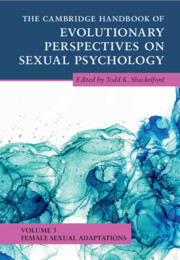Book contents
- The Cambridge Handbook of Evolutionary Perspectives on Sexual Psychology
- The Cambridge Handbook of Evolutionary Perspectives on Sexual Psychology
- Copyright page
- Contents
- Contributors
- Preface
- Part I Precopulatory Adaptations
- Part II Copulatory Adaptations
- 8 Sexual Fantasies
- 9 Copulatory Thrusting
- 10 Female Provision of Oral Sex
- 11 The Adaptive Value of Women’s Orgasm
- 12 Copulatory Urgency: An Evolutionary Perspective of Women’s Sexual Desire
- Part III Postcopulatory Adaptations
- Index
- References
10 - Female Provision of Oral Sex
from Part II - Copulatory Adaptations
Published online by Cambridge University Press: 30 June 2022
- The Cambridge Handbook of Evolutionary Perspectives on Sexual Psychology
- The Cambridge Handbook of Evolutionary Perspectives on Sexual Psychology
- Copyright page
- Contents
- Contributors
- Preface
- Part I Precopulatory Adaptations
- Part II Copulatory Adaptations
- 8 Sexual Fantasies
- 9 Copulatory Thrusting
- 10 Female Provision of Oral Sex
- 11 The Adaptive Value of Women’s Orgasm
- 12 Copulatory Urgency: An Evolutionary Perspective of Women’s Sexual Desire
- Part III Postcopulatory Adaptations
- Index
- References
Summary
Female engagement in oral sex, both receiving and performing, is a sexual behavior found throughout the animal kingdom, yet it remains an underdeveloped research area. Regardless, proximate and ultimate causes can explain engagement in oral sex. For instance, there have been various sociocultural impacts that have led to fluctuations in the performance frequency of oral sex over human history. In this chapter, we highlight the results of research on oral sex for women. First, cross-cultural and historical practices regarding oral sex are presented to explain various fluctuations in the behavior. We also examine cross-species examples of oral sex. Second, we present contemporary research on oral sex and aspects that impact its frequency, such as peer pressure, age, and myths regarding the behavior. Third, proximate mechanisms (sexual pleasure and partner satisfaction) for engagement in oral sex are discussed. Fourth, we describe six evolutionary perspectives on oral sex and introduce one additional theory—a sexual communal perspective that integrates other models. Lastly, we note limitations and future directions for studying women's engagement in oral sex.
Keywords
- Type
- Chapter
- Information
- Publisher: Cambridge University PressPrint publication year: 2022



